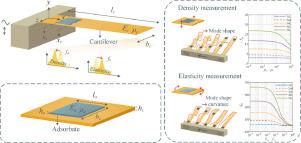International Journal of Mechanical Sciences ( IF 7.1 ) Pub Date : 2021-01-29 , DOI: 10.1016/j.ijmecsci.2021.106309 Wuweikai Xiang , Yanling Tian , Xianping Liu

|
Detection sensitivity is one of the essential indices for nano-resonator-based sensing. Multiple mechanisms, such as the counteractive effects of mass and stiffness, have been revealed to contribute to the detection sensitivity, making the sensitivity analysis a complex and under-explored issue. In this study, we develop an analytical frequency model and quantitatively reveal how the detection sensitivity relies on the complex interactions between the nano-resonator-based sensor and the biochemical adsorbate for the measurement of elasticity and density. We further specify the detection limits and approaches to enhance the detection sensitivity for mechanical properties of biochemical adsorbate in nano-resonator-based label-free measurements. Results indicate that the detection sensitivity to elasticity/density could be exponentially enhanced by decreasing the elasticity/density ratio between the adsorbate and the nano-resonator until it reaches the limit. Besides, it is effective to maximize the detection sensitivity through the deposition of the biochemical adsorbate at specific regions combined with the optimization of its geometry according to the mechanical property to be measured. The maximum detection sensitivity to the elasticity relies on the distribution and geometry of the adsorbate more than that of the density. This study provides significant insights into the identification of biochemical nano-entities and helps to enhance the accuracy and capability of the nano-resonator-based sensors in mechanical measurements.
中文翻译:

基于纳米谐振器的弹性和密度测量传感器检测灵敏度的理论分析
检测灵敏度是基于纳米谐振器的传感的重要指标之一。揭示了多种机制,例如质量和刚度的反作用效应,可以提高检测灵敏度,使灵敏度分析成为一个复杂且尚未充分研究的问题。在这项研究中,我们建立了一个分析频率模型,定量地揭示了检测灵敏度如何依赖于基于纳米谐振器的传感器与生化吸附物之间复杂的相互作用,以测量弹性和密度。我们进一步规定了检测极限和方法,以增强基于纳米谐振器的无标记测量中生化吸附物机械性能的检测灵敏度。结果表明,通过降低被吸附物和纳米谐振器之间的弹性/密度比直至达到极限,可以以指数方式提高对弹性/密度的检测灵敏度。此外,有效的是通过将生化吸附物沉积在特定区域并结合根据待测机械性能优化其几何形状来最大化检测灵敏度。对弹性的最大检测灵敏度更多地取决于被吸附物的分布和几何形状而不是密度。这项研究为生化纳米实体的鉴定提供了重要的见识,并有助于提高基于纳米谐振器的传感器在机械测量中的准确性和功能。











































 京公网安备 11010802027423号
京公网安备 11010802027423号